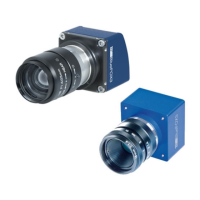and the future application you must not change the optic. To reduce errors while doing the flat-field
correction, a saturation between 50 % and 75 % of the flat-field in the histogram is convenient.
Note:
Flat-field correction can also be used as a destructive watermark and works for all f-stops.
To make a flat field correction following steps are necessary:
You need a plain and equally "colored" calibration plate (e.g. white or gray)1.
No single pixel may be saturated - that's why we recommend to set the maximum gray level
in the brightest area to max. 75% of the gray scale (i.e., to gray values below 190 when
using 8-bit values)
2.
Set the (Filter-) "Mode = Calibrate" (Figure 6)3.
Start a Live snap ("Acquire" with "Acquisition Mode = Continuous")4.
Finally, you have to activate the correction: Set the (Filter-) "Mode = On"5.
Save the settings including the correction data via "Action -> Capture Settings ->
Save Active Device Settings"
(Settings can be saved in the Windows registry or in a file)
6.
Note:
After having re-started the camera you have to reload the capture settings vice versa.
The filter snaps a number of images (according to the value of the CalibrationImageCount, e.g.
5) and averages the flat-field images to one correction image.
18 Use cases
175

